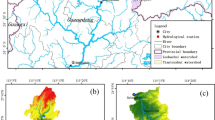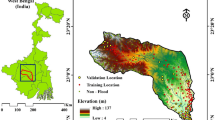Abstract
Identifying the environmental factors and analyzing the causal mechanism of flash floods help to manage the risk. Maximum 24-h precipitation (MP), digital elevation (DE), slope degree (SD), soil type (ST), drainage density (DD), and vegetation cover (VC) are selected as the risk factors of flash floods in this study. Precipitation is the important meteorological components in flash floods; thus spatial characteristics of precipitation trend have been analyzed by using Mann-Kendall tests, and a positive trend of precipitation in Upper Hanjiang River is detected. Then, association rule mining approach is proposed to investigate the multiple environmental factors of flash floods, in which both single and multiple dimension data mining have been conducted by Apriori algorithm. Considering the high rate of 5-year return period floods in the flash flood inventory, further association rule mining after sampling has been conducted in order to deeply mine the causal patterns of flash floods in different risk magnitudes. Results show that soil type, slope degree, and digital elevation are the dominant environmental factors of flash floods in the study area, and precipitation is one of the important causal factors in severe flash flood hazards. It is also highlighted that flash floods might easily occur even with a slight rainfall present due to the instability of sand clay and saturated soil moisture. The proposed novel use of field data and data mining has the potential for providing procedures and solutions for an effective interpretation of flash flood mechanism. The results are expected to be applicable for decision-making and sustainable management in flooding risk.








Similar content being viewed by others
References
Abebe Y, Kabir G, Tesfamariam S (2018) Assessing urban areas vulnerability to pluvial flooding using GIS applications and Bayesian belief network model. J Clean Prod 174:1629–1641
Agrawal R, Imielinski T, Swami AN (1993) Mining association rules between sets of items in large database. In: Proceedings of the 1993 ACM SIGMOD international conference on management of data. pp. 207–216
Guo ZH, Chi DZ, Wu J, Zhang WY (2014) A new wind speed forecasting strategy based on the chaotic time series modeling technique and the Apriori algorithm. Energ Convers Manag 84:140–151
Kadzinski M, Ciomek K, Slowinski R (2015) Modeling assignment-based pairwise comparisons within integrated framework for value-driven multiple criteria sorting. Eur J Oper Res 241(3):830–841
Karamouz M, Noori N, Moridi A, Ahmadi A (2011) Evaluation of floodplain variability considering impacts of climate change. Hydrol Process 25(1):90–103
Kaur M, Kang S (2016) Market basket analysis: identify the changing trends of market data using association rule mining. Procedia Comput Sci 85:78–85
Kendall MG (1975) Rank correlation measures. Charles Griffin, London
Lai CG, Shao QX, Chen XH, Wang ZL, Zhou XW, Yang B, Zhang LL (2016) Flood risk zoning using a rule mining based on ant colony algorithm. J Hydrol 542:268–280
Li HC, Lei XH, Shang YZ, Qin T (2018) Flash flood early warning research in China. Int J Water Resour Dev 34(3):369–385
Li ZH, Zhang HB, Singh VP, Yu RH, Zhang SQ (2019) A simple early warning system for flash floods in an ungauged catchment and application in the Loess Plateau, China. Water-Sui 11(3):426
Manfreda S (2008) Runoff generation dynamics within a humid river basin. Nat Hazard Earth Syst 8(6):1349–1357
Mann HB (1945) Non-parametric tests against trend. Econometrica 13:245–259
Marcus SS, Luis M, Carlos HRL, Leonardo ZM (2018) Links between different classes of storm tracks and the flood trends in Spain. J Hydrol 567:71–85
Milanesi L, Pilotti M, Ranzi R (2015) A conceptual model of people’s vulnerability to floods. Water Resour Res 51(1):182–197
Mosase E, Ahiablame L (2019) Rainfall and temperature in the Limpopo river basin, Southern Africa: means, variations, and trends from 1979 to 2013. Water-Sui 10(4):364
Nahar J, Imam T, Tickle KS, Chen YPP (2013) Association rule mining to detect factors which contribute to heart disease in male and females. Expert Syst Appl 40:1086–1093
Peng MK, Sundararajan V, Williamson T, Minty EP, Smith TC, Doktorchik CTA, Quan HD (2018) Exploration of association rule mining for coding consistency and completeness assessment in inpatient administrative health data. J Biomed Inform 79:41–47
Poortvliet PM, Knotters M, Bergsma P, Verstoep J, van Wijk J (2019) On the communication of statistical information about uncertainty in flood risk management. Saf Sci 118:194–204
Sayemuzzaman M, Jha MK (2014) Seasonal and annual precipitation time series trend analysis in North Carolina, United States. Atmos Res 137:183–194
Stefanidis S, Stathis D (2013) Assessment of flood hazard based on natural and anthropogenic factors using analytic hierarchy process (AHP). Nat Hazards 689(2):569–585
Xiao YF, Yi SZ, Tang ZQ (2018) A spatially explicit multi-criteria analysis method on solving spatial heterogeneity problems for flood hazard assessment. Water Resour Manag 32(10):3317–3335
Zellou B, Rahali H (2019) Assessment of the joint impact of extreme rainfall and storm surge on the risk of flooding in a coastal area. J Hydrol 569:647–665
Zhang Q, Jiang T, Chen YQD, Chen XH (2010) Changing properties of hydrological extremes in South China: natural variations or human influences? Hydrol Process 24:1421–1432
Zheng YG, Xue M, Li B, Chen J, Tao ZY (2016) Spatial characteristics of extreme rainfall over China with hourly through 24-hour accumulation periods based on national-level hourly rain gauge data. Adv Atmos Sci 33:1218–1232
Zhong M, Jiang T, Hong Y, Yang XH (2019a) Performance of multi-level association rule mining for the relationship between causal factor patterns and flash flood magnitudes in a humid area. Geomat Nat Haz Risk 10(1):1967–1987
Zhong M, Wang J, Gao L, Lin KR, Hong Y (2019b) Fuzzy risk assessment of flash floods using a cloud-based information diffusion approach. Water Resour Manag 33:2537–2553
Funding
The research has been financially supported by the Project of the National Natural Science Foundation of China (Grant No.51709286) and the Natural Science Youth Foundation of Guangdong Province (Grant No.2017A030310065).
Author information
Authors and Affiliations
Corresponding author
Additional information
Responsible editor: Philippe Garrigues
Publisher’s note
Springer Nature remains neutral with regard to jurisdictional claims in published maps and institutional affiliations.
Rights and permissions
About this article
Cite this article
Zhong, M., Jiang, T., Li, K. et al. Multiple environmental factors analysis of flash flood risk in Upper Hanjiang River, southern China. Environ Sci Pollut Res 27, 37218–37228 (2020). https://doi.org/10.1007/s11356-019-07270-9
Received:
Accepted:
Published:
Issue Date:
DOI: https://doi.org/10.1007/s11356-019-07270-9




